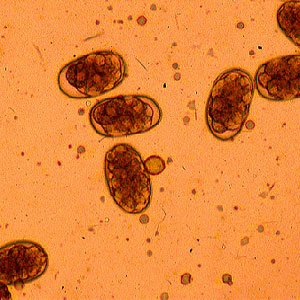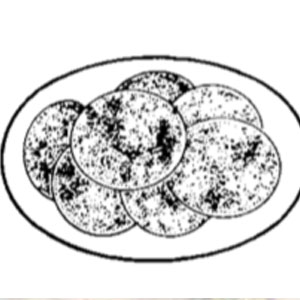Hookworms are strongyle-like parasites which belong to the Ancylostomatidae family. Two main genera of hookworms affect non-human primates: Ancylostoma and Necator (Necator americanus being the only species of the genus to affect non-human primates) (Strait et al., 2012).
Epidemiology
Hookworms can be found in Africa, Asia, and the Americas. Species of Ancylostoma are mainly found in New World Monkeys and Apes (Strait et al., 2012), while Necator americanus has been reported in New World Monkeys, Apes and Old-World Monkeys (Strait et al., 2012).
Description
Hookworm eggs have the typical morphology of a non-embryonated strongyle egg: they are oval, with a thick outer membrane, non-parallel lateral sides, and contain a morula (Garcia, 2021).
Some characteristics are specific to hookworm eggs but can sometimes be hard to detect: the morula is typically almost transparent and contains 4 to 8 blastomeres (Garcia, 2021).
Differential diagnosis
Differential diagnosis includes any non-embryonated strongyle egg.
Clinical significance
Hookworms have been described to cause clinical signs both in non-human primates and humans: Ancylostoma duodenale and Necator americanus are transmissible to humans. They cause anemia, eosinophilia, expiratory dyspnea, abdominal distension, and general weakness (Strait et al., 2012).
Prophylaxis and treatment
As hookworms are zoonotic pathogens, hygienic measures need to be taken in case of diagnosis. Various treatments have been described to treat hookworm infections in non-human primates, namely:
- Ivermectin: 200 µg/kg IM once, repeated 3 weeks later if necessary (Strait et al., 2012);
- Tetramisole: 12-16 mg/kg PO once (Strait et al., 2012) ;
- Mebendazole: 15 mg/kg PO q24h during 2 days OR 4 mg/kg PO q24h during 10 days (Strait et al., 2012);
- Levamisole: 7.5 mg/kg SC twice two weeks apart (Strait et al., 2012);
- Fenbendazole: 25 mg/kg PO twice one week apart (Calle & Joslin, 2015).



